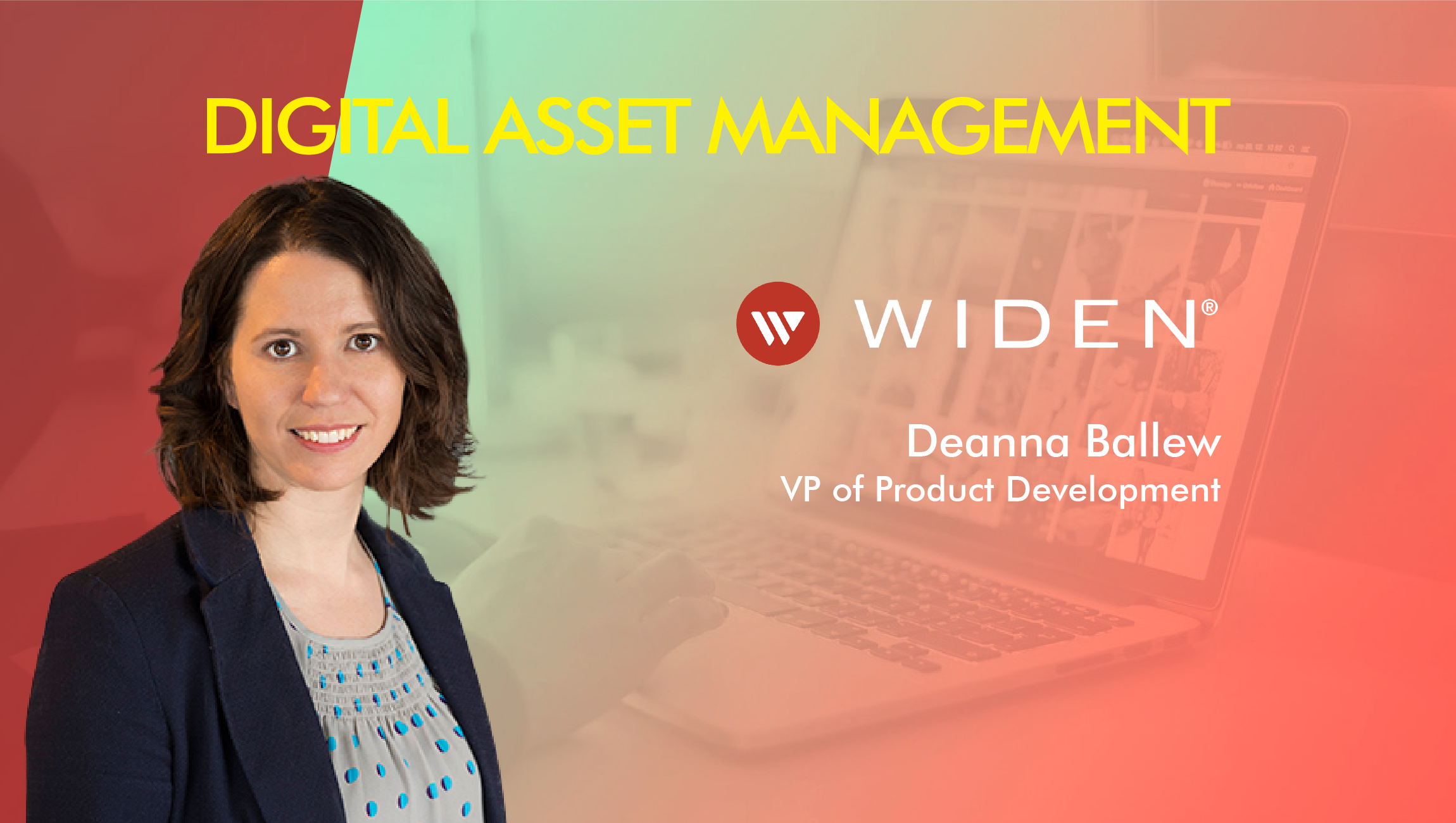Deanna Ballew
VP, Product Development, Widen
In a recent article, we mentioned how Product Reviews and Recommendations could be a central asset to your entire Content Marketing strategy in 2018. We spoke to Deanna Ballew, VP, Product Development, Widen, to understand what data points should Product Development teams focus on to close the gap in their Digital Asset Management (DAM) platforms that deliver consistent product recommendations and customer experiences.
Html code here! Replace this with any non empty text and that's it.
Tell us about your role at Widen and the team/ technology you handle.
I’m the VP of Product Development at Widen. We provide digital content solutions for more than 600 global companies. During my 14 years at Widen, I have been shaping our Digital Asset Management solution. In the 2000s, we transitioned from a print services provider into a software company and adopted formal product management. Now, our product management practice straddles software engineering, business strategy, and marketing. I work hand in hand with Widen’s VP of Marketing, Jake Athey, to set our vision. I align the vision across a talented team of product managers, user experience experts, software engineers, and testers to deliver that vision through software solutions.
How do you define your ‘Ideal Customer’ profile? How does a standard customer definition enable you to ensure smooth Product Management?
The role of a product manager at Widen is to deliver solutions that solve customers’ problems. Choosing which problems to focus on is the toughest part of the role. We continually assess which problems are going to have the greatest impact, which ones are delighters, and which ones will propel us in the market.
In shaping the vision of our product, we seek out ideal customers who consistently use our platform across their content lifecycle. From there, we approach customers who value a reciprocal partnership and are able to give us candid feedback. They have a vision for how our product will enable their company to expand. We actively listen to them and observe their needs so we can uncover opportunities to solve problems that will make a difference.
Once we have identified problem areas that are common to many customers, we assess the value of solving a given problem relative to other roadmap items.
In short, our ideal customers give our product teams a broad range of problems to explore without locking us into one direction.
What data points help you close the gap between product recommendations and real customer experiences?
To close the gap between product recommendations and customer experiences, we ask and observe the customer. Their experience spans across their time in the product, use of services, and participation in the broader Widen Community. To provide value, we break down the entire customer journey and seek data from each key step.
Many of our data points come from qualitative methods. Surveys, user research, and win/loss interviews are extremely valuable in understanding our current customers and potential customers. These also uncover areas of weakness where we need to improve our product, service or community.
I cannot say enough about user testing and observing customers live as they struggle with your product and completing tasks. It is extremely eye-opening and reveals whether we are on the right path or not. It’s also an extremely good exercise of patience to not “assist” the user in completing the task!
For quantitative data points, we analyze product usage. Out of the customers who are using the new functionality, how are they using it and how often?
When we combine qualitative and quantitative data, we can identify the synergy of what is working for users and where we need to apply more attention.
On what factors should a modern business choose a Digital Asset Management Platform?
A modern business has many priorities and goals besides Digital Asset Management. The platform needs to support those initiatives and complement the company’s core mission. The hard part of implementing new technology is the change management within teams and push for adoption. For success, you’ll want a provider that offers implementation services and can bring the expertise you need to grow adoption and build a holistic martech stack.
This expertise includes integrations with your other technologies. Modern businesses have rich technology stacks with many tools, and Digital Asset Management plays a central part. In a recent customer visit, our technology audit revealed around 270 different software tools used across sales and marketing teams. The DAM platform needs pre-built integrations for simple connections and an adaptable API for robust custom integrations where needed.
Technology is changing rapidly. Your digital asset management platform should have a proven track record of longevity and innovation to ensure it will grow with your company and the technology landscape. Look for platforms that are battle tested and have a strong release cadence.
Modern businesses have modern users! These users expect a simple platform that meets their needs. To meet these expectations, you need teams that learn and innovate by listening to and observing users. Not only should the vendor have a dedicated user experience team with support from leadership, it should have a user-centered mindset where everyone across the company seeks to deliver the best experience. At Widen, we have set goals and expectation for the whole product development team to take time for onsite visits and sit in usability tests. The only way for us to build products that meet our customers’ expectations is to understand the people using them at every touchpoint.
What are the major challenges in the way product management officers deal with the Software Development, Infrastructure, and Quality Assurance teams? How do you meet those challenges at Widen?
Time and roadmap! Every customer wants to know, “When is ____ going to be delivered?” And every engineering team responds, “Here is my best estimate.” The tension between curiosity about dates and reality about workload in development means that product managers representing their customers’ concerns can find themselves in a tough spot with the engineering team.
At Widen, we have solved this problem with transparency for both our customers and our engineering teams. Product managers invite both customers and internal teams to an online roadmap where customers can vote and comment. Items on the roadmap start as high-level themes and get more detailed through the development process. Customers are able to see what items are priorities ahead of other needs. Internal teams get to see the comments on why items are important and reach out for more details during the development process.
This practice sets transparent expectations and creates shared appreciation between engineering and customers. Instead of setting false expectations and a delivery date with a customer, they watch it progress and know when to expect it. Instead of engineering teams feeling pressured to deliver a laundry list of requirements, they see the value that it brings and find creative ways to deliver value every two weeks to our customers.
After a year of innovating without a timeframe or static roadmap, I’m starting to see some interesting outcomes. Recently, I spoke with a software developer on my team who suggested we give product managers high-level estimates 6 to 9 months out, to better set customer expectations. He had just observed several interviews in which customers asked for timeframes. My response as the Product Manager was no — we don’t want to lock ourselves into a timeframe when instead we could work with customers to solve more valuable problems that we uncover along the way. Our customers participate in an average of six user testing sessions per week and tell us how we can better meet their needs.
What are your predictions on AI/ML capabilities helping Product Development teams achieve better automation and higher productivity?
In product development, AI/ML can change the way we identify and solve problems.
When we look for problems to solve, we usually have a hypothesis. We dig into small subsets of data that we have access to and the ability to synthesize. However, we know that there is an immense, untapped datastore on customer preferences. Machine learning could uncover new patterns and problems that were unknown to us. It gets even more interesting if, someday, we can predict the success of a product or idea through machine learning and predictive analytics.
At Widen, we often brainstorm how AI can help us solve our customers’ problems. By leveraging AI within our product, we could personalize the experience based on the user actions. Users could explore data that is of interest to them instead of first having to search for it and hope they find what they need. Searching for data is a chore and users hope they can enter the right syntax in the right order to find what they need. With AI, users could explore data that is relevant to them and be immersed in a new experience.
As AI becomes refined and accessible, we know it will make a significant impact. The general principles of DAM will hold true, but AI techniques could reduce the time spent on our product and deliver richer experiences.
Thanks for chatting with us, Deanna.
Stay tuned for more insights on marketing technologies. To participate in our Tech Bytes program, email us at news@martechseries-67ee47.ingress-bonde.easywp.com











